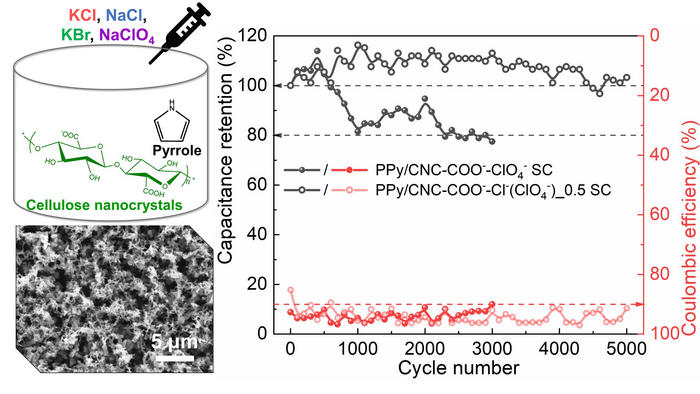Polypyrrole (PPy) is widely used as an electrode material in supercapacitors (SCs) due to its high conductivity, low cost, and ease of handling and fabrication. However, its limited capacitance and poor cycling stability hinder its practical applications. The cycling stability of Ppy has been considerably improved through the use of carboxylated cellulose nanocrystals (CNC-COO−) as immobile dopants. Our previous work showed that PPy SCs doped with immobile CNC-COO− could retain 86% of the original capacitance after 1000 cycles, 70% capacitance after 10000 cycles, and 47% of its capacity after 50000 cycles. By adding KCl into a pyrrole (Py) and CNC-COO− electrodeposition electrolyte, PPy SCs with improved homogeneity, porosity, and interconnectivity were fabricated, which retained 111.2% of the initial capacitance after 3000 cycles. KCl serves as a supporting electrolyte for the electropolymerization of PPy and contributes to the development of the three-dimensional porous structure when combined with CNC-COO−. The relatively high cycling stability of PPy films is ascribed to the interconnected porous structure and the rigid and immobile CNC-COO−.

Credit: Journal of Energy Chemistry
Polypyrrole (PPy) is widely used as an electrode material in supercapacitors (SCs) due to its high conductivity, low cost, and ease of handling and fabrication. However, its limited capacitance and poor cycling stability hinder its practical applications. The cycling stability of Ppy has been considerably improved through the use of carboxylated cellulose nanocrystals (CNC-COO−) as immobile dopants. Our previous work showed that PPy SCs doped with immobile CNC-COO− could retain 86% of the original capacitance after 1000 cycles, 70% capacitance after 10000 cycles, and 47% of its capacity after 50000 cycles. By adding KCl into a pyrrole (Py) and CNC-COO− electrodeposition electrolyte, PPy SCs with improved homogeneity, porosity, and interconnectivity were fabricated, which retained 111.2% of the initial capacitance after 3000 cycles. KCl serves as a supporting electrolyte for the electropolymerization of PPy and contributes to the development of the three-dimensional porous structure when combined with CNC-COO−. The relatively high cycling stability of PPy films is ascribed to the interconnected porous structure and the rigid and immobile CNC-COO−.
Recently, the Sustainable Materials Lab at KU Leuven,published an article titled “Interconnected and high cycling stability polypyrrole supercapacitors using cellulose nanocrystals and commonly used inorganic salts as dopants” in the Journal of Energy Chemistry.
The authors investigated the effect of different commonly used salts (KCl, NaCl, KBr, and NaClO4) and CNC-COO− as dopants during electropolymerization on the morphology and electrochemical performance of PPy SCs. They found that the capacitance of the electrode film increased from 160.6 to 183.4 F g−1 when using a combination of KCl and NaClO4 in the electrodeposition electrolyte. A porous and interconnected PPy/CNC-COO−-Cl−(ClO4−)_0.5 electrode film of an aqueous solution containing 160.7 mM pyrrole, 13.4 mM CNC-COO–, 18 mM of KCl, and 9 mM NaClO4 was deposited. This film exhibited an excellent capacitance of 125.0 F g−1 (0.78 F cm−2) at a high current density of 2.0 A g−1 (20 mA cm−2, can be charged in less than 1 min), which is almost 204% that of PPy/CNC-COO− films. A symmetric PPy/CNC-COO−-Cl−(ClO4−)_0.5 SC was developed, which retained its full capacitance after 5000 cycles and displayed a high energy density of 5.2 Wh kg−1 (34.5 μWh cm−2, 6.6 mg cm-2). This works demonstrates a simple and practical approach for depositing PPy-based SCs featuring a high capacitance, fast charging capability, and high cycling stability.
About the journal
The Journal of Energy Chemistry is a publication that mainly reports on creative researches and innovativeapplications of chemical conversions of fossil energy, carbon dioxide, electrochemical energy and hydrogen energy,as well as the conversions of biomass and solar energy related with chemical issues to promote academicexchanges in the field of energy chemistry and to accelerate the exploration, research and development of energyscience and technologies.
At Elsevier
https://www.sciencedirect.com/journal/journal-of-energy-chemistry
Manuscript submission
https://www.editorialmanager.com/jechem/default.aspx
DOI
10.1016/j.jechem.2022.09.024



